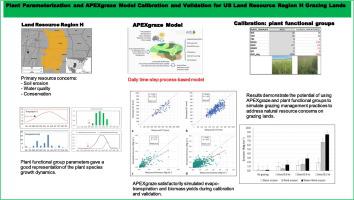Agricultural Systems ( IF 6.6 ) Pub Date : 2023-03-16 , DOI: 10.1016/j.agsy.2023.103631 Manyowa N. Meki , Javier Osorio-Leyton , Evelyn M. Steglich , Jim R. Kiniry , Marco Propato , Mike Winchell , Hendrik Rathjens , Jay P. Angerer , Lee M. Norfleet

|
CONTEXT
Grazing lands account for 66.7% of all agricultural land in the United States. Soil erosion, water quality and conservation have been identified as primary resource concerns on grazing lands. Biophysical models driven by daily climatic variables enable assessment of natural resource management options over time and across large landscapes, especially where on-the-ground assessments are not feasible.
OBJECTIVE
The objectives of the study were to develop plant functional groups to parameterize, calibrate and validate the APEXgraze model. The calibrated and validated model was applied to demonstrate its potential to evaluate environmental resource concerns and ecosystem services on grazing lands as impacted by increased cattle stocking densities, initially focusing on Land Resource Region (LRR) H - the Central Great Plains.
METHODS
Because of the high plant species variability in grazing lands, APEXgraze was calibrated using plant functional groups. A total of 64 plant functional groups were identified as representing plant species in the Central Great Plains. When the functional group parameters were incorporated into the APEXgraze model, along with the soils data, daily weather, and a zero-grazing management system, the functional group parameters gave a reasonable representation of the plant species growth dynamics, to include leaf area development and biomass yields. The calibrated and validated model was applied to demonstrate its potential application to evaluate the impacts of high cattle stocking densities on evapotranspiration, surface runoff, water stress, water and wind erosion, and soil organic carbon storage.
RESULTS AND CONCLUSIONS
Overall, model evaluation metrics indicated satisfactory performance by APEXgraze during calibration and validation against evapotranspiration (ET) data for the contiguous United States and National Resources Inventory (NRI) reconstructed field-measured biomass yields. Mean simulated ET values were reasonable, and within 10% of observed ET values. The model was able to explain 98% (R2) of the variance in observed ET values in both calibration and validation. In addition, Nash-Sutcliffe Efficiency (NSE) was >0.50, and Willmott's d was closer to 1 (> 0.80) in both calibration and validation. Aboveground biomass calibration and validation metrics were not as strong as those for ET. Still, overall model evaluation metrics indicated satisfactory performance by APEXgraze. Simulated mean biomass yields were respectively within 16% and 11% of measured biomass yields during calibration and validation. The model was able to explain 75% (R2) of the variance in measured biomass yields during calibration and 70% of the variance during validation. Both NSE and d were respectively >0.50, and closer to 1 (> 0.80) in both calibration and validation. APEXgraze's utility was successfully demonstrated by its potential application to evaluate the impacts of high cattle stocking densities on evapotranspiration, surface runoff, water stress, water and wind erosion, and soil organic carbon storage on grazing lands.
Significance
Following successful calibration and validation, the APEXgraze model was applied to demonstrate its potential application to evaluate environmental resource concerns and ecosystem services on grazing lands as impacted by increased stocking densities.
中文翻译:

美国土地资源区 H 牧地的植物参数化和 APEXgraze 模型校准和验证
语境
牧场占美国所有农业用地的 66.7%。水土流失、水质和保护已被确定为牧场的主要资源问题。由日常气候变量驱动的生物物理模型能够随着时间的推移和大片景观评估自然资源管理方案,尤其是在实地评估不可行的情况下。
客观的
该研究的目标是开发植物功能组以参数化、校准和验证 APEXgraze 模型。应用经过校准和验证的模型来展示其评估受牛放养密度增加影响的牧场环境资源问题和生态系统服务的潜力,最初侧重于土地资源区 (LRR) H - 大平原中部。
方法
由于牧场的植物种类差异很大,因此使用植物功能组对 APEXgraze 进行了校准。共有 64 个植物功能组被确定为代表大平原中部的植物物种。当功能组参数与土壤数据、日常天气和零放牧管理系统一起被纳入 APEXgraze 模型时,功能组参数合理地表示了植物物种的生长动态,包括叶面积发育和生物量产量。应用经过校准和验证的模型来展示其潜在应用,以评估高牛放养密度对蒸发蒸腾、地表径流、水分胁迫、水蚀和风蚀以及土壤有机碳储存的影响。
结果和结论
总体而言,模型评估指标表明 APEXgraze 在针对连续的美国和国家资源清单 (NRI) 重建的现场测量的生物量产量的蒸发蒸腾 (ET) 数据进行校准和验证期间表现令人满意。平均模拟 ET 值是合理的,在观察到的 ET 值的 10% 以内。该模型能够解释 98% (R 2) 在校准和验证中观察到的 ET 值的方差。此外,Nash-Sutcliffe 效率 (NSE) > 0.50,Willmott's d 在校准和验证中都接近 1 (> 0.80)。地上生物量校准和验证指标不如 ET 强。尽管如此,总体模型评估指标表明 APEXgraze 的性能令人满意。在校准和验证期间,模拟的平均生物量产量分别在测量的生物量产量的 16% 和 11% 以内。该模型能够解释 75% (R 2) 校准期间测量的生物量产量的方差和验证期间 70% 的方差。NSE 和 d 分别 > 0.50,并且在校准和验证中都更接近 1 (> 0.80)。APEXgraze 的实用性已通过其潜在应用成功证明,该应用可用于评估高放养密度对牧场蒸发蒸腾、地表径流、水分胁迫、水蚀和风蚀以及土壤有机碳储存的影响。
意义
在成功校准和验证之后,应用 APEXgraze 模型来展示其在评估受放养密度增加影响的放牧地环境资源问题和生态系统服务方面的潜在应用。



























 京公网安备 11010802027423号
京公网安备 11010802027423号